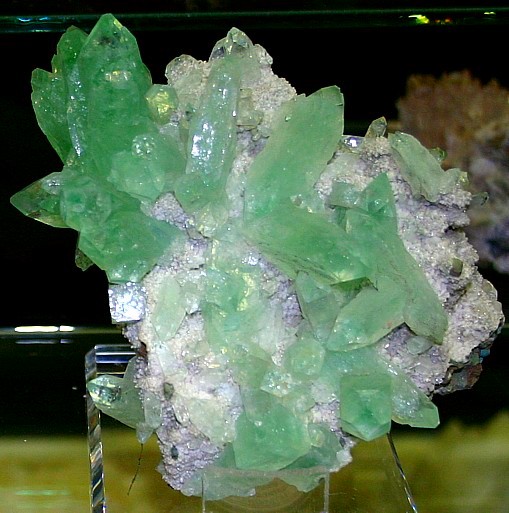|
.
Apophyllite Mineral Facts:
Chemical Formula:
KCa4Si8O20(OH,F)-8H2O
Member of a group known as the
phyllosilicates.
Colors:
white, grayish, green, flesh-colored or red, and transparent.
Its streak is white.
Hardness: 4.5
to 5
Density: 2.3
to 2.4
Cleavage:
Perfect basal cleavage.
Crystallography:
Tetragonal
Usually shows a combination of prism of second order, pyramid of first
and basal plane. The mineral also occurs in granular and lamellar
masses.
Luster:.
Luster of base pearly, other faces vitreous; Transparent to opaque.
Optics:
(Refractive Index): w=1.5356, e=1.5368.
|

Above: Apophyllite |
|
.
Composition,
Structure and Associated Minerals:
Apophyllite differs from the zeolites in
containing no aluminum
and in having some of its water replaced by fluorine; but in its general
appearance and its manner of occurrence it is like them.
It occurs commonly as a
secondary mineral lining cavities in basalt and related igneous rocks.
Apophyllite is associated with various zeolite minerals, as well as with
calcite, datolite, pectolite, etc.
Identification and Diagnostics
Fuses easily with swelling to a white vesicular enamel. Colors the
flame pale violet (test for potassium). Yields 16 per cent of water in the
closed tube. Decomposed by hydrochloric acid with separation of silica but
without the formation of a jelly. Solution gives little or no precipitate
with ammonia but gives an abundant white precipitate with ammonium carbonate
(calcium carbonate). Recognized usually by its crystals, color, luster and
basal cleavage. |

|
|
|
Occurrence,
Localities and Origins:
Apophyllite
occurs in the cavities of volcanic rocks, in veins in granite and gneiss
and in ore veins and ore deposits in limestone. It is also found in the
rocks surrounding hot springs. Under some conditions it alters to
calcite,
and to pectolite.
The name Apophyllite is derived
from two Greek words meaning to get leaves, because of its tendency to
exfoliate when ignited.
Localities. Good crystals of apophyllite occur at St. Andreasberg and
Radauthal, Harz; at Striegau, Silesia; near Cipitbach, in the Seisser Alps,
Tyrol; in the magnetite mines at Uto, Sweden; at Disko, Greenland; at many
points in eastern Nova Scotia;
Faroer Islands, Iceland; in the
silver ores
of Guanjuato, Mexico; near Bombay, India;
and at Santa Barbara, in Brazil. The mineral has also been described
from the ruins of old Roman masonry around hot springs.
In the US it is found in fine
crystals
at Bergen Hill, N. J.;
Table Mountain, near Golden,
Colorado;
Cliff Mine,
Lake Superior copper district; and in the mercury mines of New Almaden,
California.
Return to the
Mineral Collectors Information Page |


